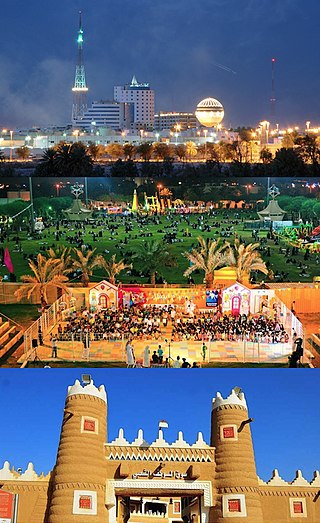
The Qassim Province, also known as the Qassim Region, is one of the 13 provinces of Saudi Arabia. Located at the heart of the country near the geographic center of the Arabian Peninsula, it has a population of 1,336,179 and an area of 58,046 km2. It is known to be the "alimental basket" of the country, for its agricultural assets.

The Eastern Province, also known as the Eastern Region, is the easternmost of the 13 provinces of Saudi Arabia. It is the nation's largest province by area and the third most populous after the Riyadh and Mecca provinces. In 2017, the population was 4,900,325. Of these, 3,140,362 were Saudi citizens and 1,759,963 were foreign nationals The province accounts for 15.05% of the entire population of Saudi Arabia and is named for its geographical location relative to the rest of the kingdom.

Ḥaʼil Province, also known as the Ha'il Region, is one of the 13 provinces of the Kingdom of Saudi Arabia. It is the eighth-largest province by area at 103,887 km2 (40,111 sq mi) and the ninth-largest by population, with the population in 2019 being 731,147. The province accounts for roughly 2% of the population of the country and is named for its largest city, Ha'il. Other populous cities in the province include al-Ghazalah, Shinan and Baq'aa. The region is famous for the twin mountain ranges of 'Aja and Salma, and for being the homeland of historic symbol of curiosity and generosity, Hatim al-Ta`i.

The Rashidi dynasty, also called Al Rashid or the House of Rashid, was a historic Arabian House or dynasty that existed in the Arabian Peninsula between 1836 and 1921. Its members were rulers of the Emirate of Ha'il and the most formidable enemies of the House of Saud, rulers of the Emirate of Nejd. They were centered in Ha'il, a city in northern Najd that derived its wealth from being on the route of the Hajj pilgrimage to Mecca, and was also a commercial center. The rulers of Ha'il were the sons of Abdullah bin Rashid, founder of the dynasty.

The tribe of Shammar is a tribal Arab Qahtanite confederation, descended from the Tayy, which migrated into the northern Arabian Peninsula from Yemen in the second century. It is the largest branch of the Tayy, and one of the largest and most influential Arab tribes. The historical and traditional seat of the tribe's leadership is in the city of Ḥaʼil in what was the Emirate of Jabal Shammar in what is now Saudi Arabia. In its "golden age", around 1850, the Shammar ruled much of central and northern Arabia from Riyadh to the frontiers of Syria and the vast area of Upper Mesopotamia.

Haʼil is a city in north-western Saudi Arabia. It is the capital and largest city of Ha'il Region, with a population of about 498,575 (2022).
Barzan is a Kurdish village located on the Northern shores of the Great Zab River in Erbil Governorate in Kurdistan Region, Iraq.
Ansar, Al Ansar, or Al-Ansar may refer to:
Zahra or Zehra may refer to:

Articles related to Saudi Arabia include:

The following outline is provided as an overview of and topical guide to Saudi Arabia:

Barzan was a historical palace in Ha'il, Saudi Arabia. Its construction was begun in 1808 by Prince Muhammad bin Abdul Muhsin Al Ali. The palace was completed during the rule of the second Rashidi amir, Talal bin Abdullah.

Arar is the capital of Northern Borders Province in Saudi Arabia. It has a population of 202,719.

Erbil, also called Hawler, is the capital and most populated city in the Kurdistan Region of Iraq. The city is in the Erbil Governorate.
The Subdivisions of Saudi Arabia, officially the Organization of the Kingdom of Saudi Arabia, as provided by the Regions' System, issued on 27 Sha'baan 1412 AH by Royal Order A/92, amended by Royal Order No. A/21 on 30 Rabi' al-Awal 1414 AH, divided the Kingdom of Saudi Arabia into 13 emirates (provinces/regions); the 13 provinces further divided into 118 governorates, classified category (A) or category (B); the 118 governorates divided into a number of centers, category (A) and category (B), taking into consideration the housing, geographical, security, transport, environment and historic conditions of each region.

The Emirate of Jabal Shammar, also known as the Emirate of Haʾil or the Rashidi Emirate, was a state in the northern part of the Arabian Peninsula, including Najd, existing from the mid-nineteenth century to 1921. Jabal Shammar in English is translated as the "Mountain of the Shammar". Jabal Shammar's capital was Ha'il. It was led by the monarchy of the Rashidi dynasty. It included parts of modern-day Saudi Arabia, Iraq, and Jordan.

Mergasor District is a district in northern Erbil Governorate in Kurdistan Region.

Pendro is a village in the Erbil Governorate of Kurdistan Region in Iraq. It is close to the border with Turkey and approximately 15–18 km to the north of Barzan. It is in the territory of the Muzuri tribe and Mount Butin is about 4 km northeast of Pendro. The area of Pendro covers over 10 km2 (4 sq mi). The terrain is highly mountainous, lying within the Zagros; less than 10% of the Pendro is below 1,225 m (4,019 ft), and its highest point is 2,534 m (8,314 ft).
Qahtan and Qahtani (Kahtani) or with the definite article al- as Al-Qahtani (Al-Kahtani) meaning coming from Qahtan may refer to:











